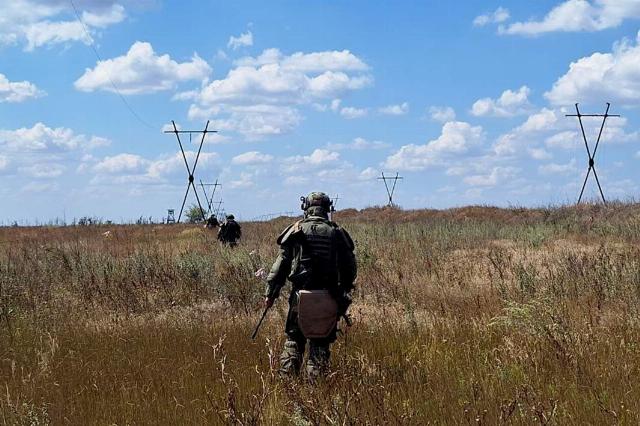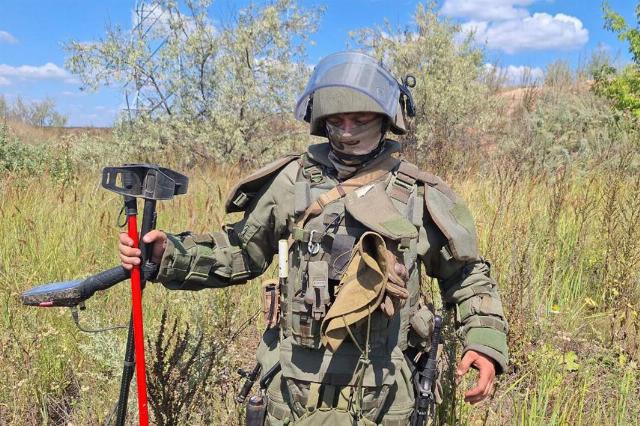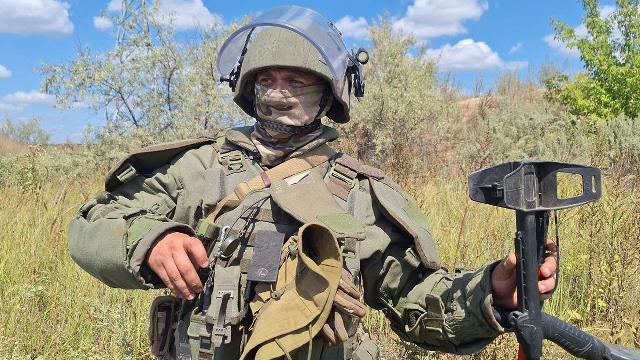Engineering units neutralize conventional and cluster munitions, tricky traps
Continuous mine clearance in Donbass is taking place in vast territories that have been trapped in the rear as a result of the successful offensive of the Russian army. In places where there was a cutting edge until recently, sappers encounter the latest Western ammunition, elements of cluster shells and sophisticated traps. Izvestia correspondents saw how soldiers from the 48th separate engineer battalion of the 51st Army of the Southern Military District were clearing mines around power lines and learned what problems they were facing.
The difficulties of clearing the territory after the fighting
We are driving along the road near Avdiivka. There is a power line running along it. After many years of fighting, it is seriously damaged and still not working, although some of the poles are intact. In March 2024, while reporting from the liberated city, we had already been here, but the roadsides were a continuous danger zone — mine clearance was carried out only in the city itself, and there was a high risk of encountering unexploded shells and booby traps outside.

Photo: IZVESTIA/Dmitry Astrakhan
Image source: iz.ru
And now there is a continuous mine clearance along the power line — this is not just the elimination of explosive objects, but a complete cleaning of the territory. After that, you can start full-fledged restoration work. The heroes of our last year's reportage are also engaged in cleaning the land.
— It's a little easier to work here than on the front line — drones are less of a hindrance. You can focus on what's under your feet, not in the sky," explains a sapper with the call sign Krugly. — The continuous mine clearance that we conduct is when you take out absolutely everything from the ground that is related to military operations, down to small fragments.
Traps are often waiting for sappers. These are not only mines with various types of mine clearance protection or disguised as terrain details, vegetation. There are also mined household items, first-aid kits, and children's toys. Almost anything from a pack of cigarettes to a tin can can be dangerous.
— The hardest thing is when Ukrainians mine the bodies of civilians or their fighters. It's even morally hard to look at, it's inhumane. I saw this in Avdiivka, when a corpse presses a bracket on a grenade without a check. The enemy is not shy in his means, has neither morals nor any boundaries," says Krugly.

Photo: IZVESTIA/Dmitry Astrakhan
Image source: iz.ru
Continuous mine clearance is now taking place in huge areas, they are increasing along with the movement of our troops forward.
— Our engineering units have covered more than 5.5 thousand hectares during their work. More than 25 thousand explosive objects have been neutralized. In Avdiivka there are more than 300 hectares and 11 thousand explosive objects, in Ukrainsk there are more than 250 hectares and 3.5 thousand objects," says the deputy platoon commander Grek.
One of the additional problems when working in cities is the inability to use mine detectors: there is too much metal around. Robots are also not very useful in building, so engineers have to do most of the work, relying on their experience and care, using probes and tools. But in open spaces, outside of cities, metal detectors are more effective.
How the sappers are clearing the area
Today, work is underway under the scorching sun, in 30-degree heat. The fighters "ledge", one by one, walk along the power line through a field overgrown with tall grass and weeds. All those kilometers that the Greek is talking about were covered exactly like that, step by step. Hangers with a tape keeper are put up every few meters, a metal detector can be heard periodically, and someone falls heavily to one knee under 40 kg of equipment and tools. And so — for six hours a day.
A sapper with the call sign Sailor shows us his set of uniforms: a helmet with a heavy face shield, an anti-splinter jumpsuit, a bulletproof vest with additional shoulder and groin protection, and a large tool bag. On the chest there is a sapper multitool attached to the sling of the vest, a small additional probe. There is a pinpoint pin on one hip for precise search of small metal objects in the ground. On the other is a small sapper shovel: a universal tool with a saw, a blade and another collapsible probe in the handle.
— It's not over yet. She's getting close, of course. But it will take dozens, I think at least 50 years, to completely clean up the DPR alone. And there are also the Kherson, Zaporizhia regions and the LPR. But it's real," says the Sailor.
Photo: IZVESTIA/Dmitry Astrakhan
Image source: iz.ru
Now the enemy is adding work to the sappers in territories that have already been cleared. The sailor tells how, after the recent major shelling of the DPR, he participated in the clearance of Ukrainian drones shot down by our air defense and the destruction of their combat units. The most difficult task was the destruction of French mines with target sensors, magnetic field change devices and seismic sensors.
— Fortunately, they were noticed in advance, and the sapper did not practice close up. They launched their drones and destroyed them on the spot. They go as anti—mining, but there are enough explosives there to leave a wet spot from the sapper," explains the Sailor.
Over the years, engineers have encountered hundreds of different types of ammunition from dozens of Western countries. From the rare ones that the Sailor is talking about, to the elements of 155-mm cluster shells that were supplied by the millions. Many of them remain in the fields and ruins and can go off at any moment.
Dmitry Astrakhan

